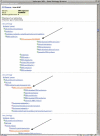Creating the gene ontology resource: design and implementation
- PMID: 11483584
- PMCID: PMC311077
- DOI: 10.1101/gr.180801
Creating the gene ontology resource: design and implementation
Abstract
The exponential growth in the volume of accessible biological information has generated a confusion of voices surrounding the annotation of molecular information about genes and their products. The Gene Ontology (GO) project seeks to provide a set of structured vocabularies for specific biological domains that can be used to describe gene products in any organism. This work includes building three extensive ontologies to describe molecular function, biological process, and cellular component, and providing a community database resource that supports the use of these ontologies. The GO Consortium was initiated by scientists associated with three model organism databases: SGD, the Saccharomyces Genome database; FlyBase, the Drosophila genome database; and MGD/GXD, the Mouse Genome Informatics databases. Additional model organism database groups are joining the project. Each of these model organism information systems is annotating genes and gene products using GO vocabulary terms and incorporating these annotations into their respective model organism databases. Each database contributes its annotation files to a shared GO data resource accessible to the public at http://www.geneontology.org/. The GO site can be used by the community both to recover the GO vocabularies and to access the annotated gene product data sets from the model organism databases. The GO Consortium supports the development of the GO database resource and provides tools enabling curators and researchers to query and manipulate the vocabularies. We believe that the shared development of this molecular annotation resource will contribute to the unification of biological information.
Figures


References
-
- Adams MD, Celniker SE, Holt RA, Evans CA, Gocayne JD, Amanatides PG, Scherer SE, Li PW, Hoskins RA, Galle RF, et al. The genome sequence of Drosophila melanogaster. Science. 2000;287:2185–2195. - PubMed
-
- Delozier EP, Lingle VA. MEDLINE and MeSH: Challenges for end users. Med Ref Serv Q. 1992;11:29–46. - PubMed
Publication types
MeSH terms
Grants and funding
- U41 HG001315/HG/NHGRI NIH HHS/United States
- HD33745/HD/NICHD NIH HHS/United States
- U41 HG002273/HG/NHGRI NIH HHS/United States
- P41 HG001315/HG/NHGRI NIH HHS/United States
- R01 HD033745/HD/NICHD NIH HHS/United States
- P41 HG00330/HG/NHGRI NIH HHS/United States
- P41 HG00739/HG/NHGRI NIH HHS/United States
- P41 HG002273/HG/NHGRI NIH HHS/United States
- P41 HG000330/HG/NHGRI NIH HHS/United States
- U41 HG000739/HG/NHGRI NIH HHS/United States
- R01 HG002273/HG/NHGRI NIH HHS/United States
- P41 HG01315/HG/NHGRI NIH HHS/United States
- HG02273/HG/NHGRI NIH HHS/United States
- P41 HG000739/HG/NHGRI NIH HHS/United States
LinkOut - more resources
Full Text Sources
Other Literature Sources
Medical
Molecular Biology Databases
